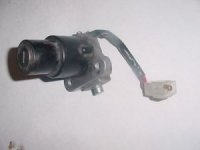Yes, it's possible to remove and swap lock cylinders. Peanut's write-up stops just short of showing you how to do that, don't know why. If you're going to clean out your ignition switch, you might as well do the whole thing, not a half-assed partial job. The lock cylinder and it's parts usually need cleaning and greasing too. Disassemble your switch as far as Peanut's write-up shows. You will be left with the lock cylinder in the housing. There is a small spring on top of it that will lift right off. Remove it. Don't mind the arrow in the pic below, that is pointing out the plunger that gets pushed down in when you push the key cylinder down to enable the fork lock function .....
Once you pull the little spring off, you may need to wipe some grease away and you'll see a brass plate sticking out of the side of the lock cylinder. That's what holds it in the housing .....
Using a small screwdriver or pick of some sort, push that plate into the lock cylinder and the cylinder can be slid out the top of the housing .....
Take care while removing it and watch that none of the spring-loaded wafers get ejected out the side. You may need to hold them in with a finger as you pull the cylinder out. They are different sizes that match the key cuts so if you mix their positions up, the key won't work .....
As I mentioned, the lock cylinder and wafers usually require a cleaning too. The wafers get all tarnished and gummed up with old lube. The wafer slots in the lock cylinder along with the key slot can be all gummed up too. In the pic below, the 2 wafers on the left haven't been cleaned yet, the 3 on the right have. I polish them clean and shiny with the little wire wheel bit in a Dremel .....

